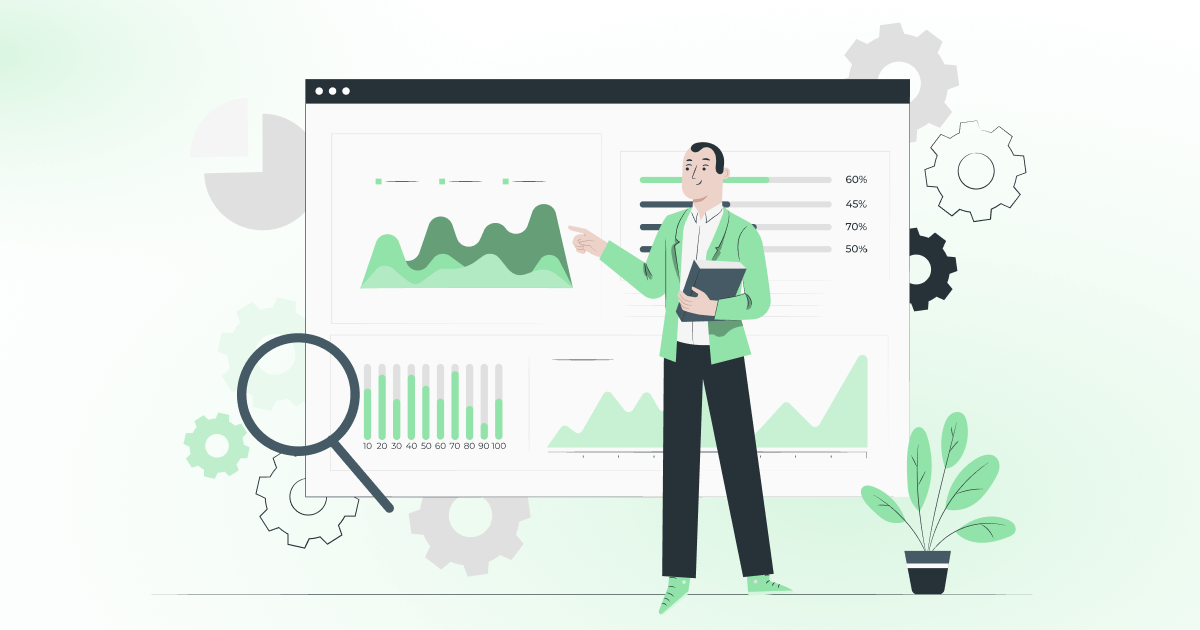
Want to know more? — Subscribe
The global big data market is about to reach $473.6 billion by 2030, with a CAGR of 12.7% from 2022 to 2030. The increasing volume, velocity, variety of data, and the adoption of advanced analytics and AI drive its growth.
With over nine years of practical experience at Softermii, we understand the importance of staying updated with the best data architecture practices.
This article aims to provide a comprehensive understanding of modern data architecture. We'll discuss the challenges the growing data landscape poses and the opportunities offered. We'll outline the best practices to guide organizations in modernizing their data architecture and share real-world cases to illustrate successful implementations of modern data centered architecture.
Understanding Modern Data Architecture
Data architecture has evolved from monolithic structures to more flexible and decentralized solutions. Technological advancements and a focus on data analytics, AI, and real-time decisions drove this transformation.
In the early days of computers, people used to store data in centralized databases with fixed structures. Later, data warehouses were developed to allow for better querying and reporting. However, these traditional architectures needed help managing data growth. Technologies like Hadoop, Spark, and NoSQL databases made it possible to store and process diverse datasets at a larger scale and faster pace. Yet, they also brought new challenges in building modern data architectures, managing and integrating the data.
The rise of cloud computing further propelled the evolution of data architecture. Cloud computing offers scalable, cost-effective solutions and leads to the advent of data lakes. In data lakes, the raw data is stored in its native format, ready for processing. When considering cloud storage, it's essential to explore strategies on how to reduce cloud storage costs to make the most of these scalable and flexible solutions.
In recent years, we've seen the emergence of a more modern approach: data mesh architecture. It treats data as a product, decentralizing the ownership and management of data to individual teams. Data mesh also promotes agility and rapid response to changing business requirements.
The journey towards data architecture modernization, while promising, also brings challenges. Some of the key hurdles include:
- data security;
- privacy concerns;
- data quality management;
- integration of different data sources;
- ensuring data governance in a decentralized environment.
These challenges can be addressed through robust policies, sophisticated tools, and the adoption of best data management practices.
In terms of opportunities, a modern data architecture offers several benefits. It facilitates the democratization of data, enabling different teams to access and use data independently. With advanced analytics and AI applications, it provides real-time insights that drive strategic decision-making. Businesses can also adapt faster to market changes, and customer demands with flexibility and scalability.
Best Practices for Modernizing Data Architecture
Data modernization of architecture is crucial for organizations to stay ahead in today's data-driven world. It is important to follow best practices that address common modernization challenges and maximize the benefits of building a modern data architecture. Let's explore them in detail:
Getting Rid of Internal Data Silos
Data silos refer to storing data in separate repositories within an organization. There is often no connection or communication between them. It occurs due to departmental segmentation, lack of integration efforts, or technological constraints. These silos impede data management, leading to inefficient decision-making and operational efficiency. Breaking them down results in more streamlined data operations, improved analytics, and informed decision-making.
Ensure All Your Data is Reliable
Data reliability signifies the accuracy and consistency of data over time. In the context of data architecture, it means that data, regardless of its source or format, is dependable and reflects reality. It is critical for effective data architecture as unreliable data can lead to erroneous insights and poor business decisions.
Ensuring data reliability enhances decision-making, analytics, and business processes. The technology involves routine data quality checks, data validation, and maintaining up-to-date, accurate information.
Data Governance and Security
Robust data governance means having clear rules and procedures for managing data. It includes how data is accessed, its quality, how different datasets are combined, and modernized data protection. With increasing concerns around data breaches and privacy regulations, ensuring data security is supreme. Cyber security best practices like encryption, anonymization, and role-based access control techniques, along with complying with relevant laws and regulations, help protect sensitive data and build trust among stakeholders.
Pick the Appropriate Tools
Modernizing data architecture requires careful selection of the right tools. This choice should align with your organization's specific needs and goals. Assess your data volume, variety, velocity, and veracity, and understand the analytical requirements and technical constraints. Consider tools and technologies tailored to your unique challenges like:
- cloud services;
- data integration tools;
- big data platforms;
- data cataloging solutions.
Additionally, these tools should support integration with your existing infrastructure to minimize disruptions.
Create for the Future
Future-proofing your data architecture ensures it remains resilient despite evolving business needs and technological advancements. Emphasize scalability, flexibility, and adaptability when designing your architecture:
- scalability allows it to handle increasing data loads;
- flexibility enables integration with emerging technologies;
- adaptability facilitates modifications in response to changing business strategies.
With this practice, your organization can handle growing data volumes, new data types, and advanced analytics capabilities.
Case Studies and Real-World Examples
The journey to data architecture modernization is unique for each organization. The specific needs and goals of the company should guide it. The choice of approach depends on the business context and the specific challenges the organization aims to address. The following cases highlight the diversity of strategies to modernize data architecture.
Airbnb: Embracing Data Democratization
Airbnb, the vacation rental marketplace, revolutionized its data architecture to foster data democratization. They developed an internal tool, "Airflow," to streamline and visualize their data workflows. It allows all team members to access, understand, and use data, promoting a data-driven culture. Airbnb tells us that a successful data architecture goes beyond data management. It's also about making it accessible and actionable for everyone in the organization.
Zalando: Evolving with Data Mesh
Zalando, a leading European e-commerce company, modernized its data architecture with a data mesh practice. They transitioned from a monolithic data lake to a decentralized system where cross-functional teams owned and managed their data products. It improved data quality, boosted innovation speed, and reduced the time needed to extract insights. Zalando's experience highlights the importance of decentralization and treating data as a product, especially for large-scale, intricate organizations.
Uber: Harnessing Real-Time Data
With millions of rides happening worldwide daily, Uber needed a data system to handle a lot of data. They created an internal platform, "AthenaX," to process streaming data in real time. It helped Uber to improve its service efficiency and provide more personalized experiences to users. The lesson from Uber is about the importance of real-time data processing in modern data systems, particularly for businesses in fast-paced environments.
LinkedIn: Data Standardization for Greater Efficiency
LinkedIn's data management modernization focused on data standardization. With a huge volume of data generated daily, the company faced challenges managing diverse data formats. To address this, LinkedIn introduced "DataHub," a tool for searching and discovering metadata. It helped improve data quality, simplified data discovery, and enhanced data management efficiency. LinkedIn's journey highlights that data standardization can be an effective strategy to improve data quality and usability. Later, the company decided to open source the tool for other organizations with intricate data systems.
Pfizer: Advancing Drug Discovery with AI and Data Analytics
Pharmaceutical giant Pfizer turned to AI and data analytics to upgrade its data architecture and speed up drug discovery. They built an AI-driven tool to analyze scientific literature and generate insights. Now, Pfizer can identify potential drug candidates faster, speeding up drug discovery. Pfizer's example demonstrates how advanced analytics and AI, powered by a strong data architecture, can drive innovation and efficiency in industries like healthcare and pharmaceuticals.
Conclusion
With data exponential growth, it's imperative to modernize data architecture. By following the techniques we've discussed, you can optimize your data management, make smarter decisions, and unlock the full potential of your data assets.
Let's recap the best practices to modernize data architecture:
- Break down internal data silos to streamline operations and improve decision-making.
- Make sure your data is reliable by checking its quality and accuracy on a regular basis.
- Focus on data governance and security to protect your sensitive information.
- Pick the right tools for your needs, whether it is cloud services, data integration tools, or other technologies.
- Future-proof your architecture by designing it to scale, adapt, and be flexible.
At Softermii, we understand the benefits and challenges of building modern data architectures and are ready to guide you on your journey. Don't hesitate to reach out to us and let us take your business to new heights.
Frequently Asked Questions
How can I ensure data security and compliance when modernizing data architecture?
When modernizing data architecture, especially in sensitive sectors like healthcare, focus on data security. Start with a strong data governance plan to keep your data safe and compliant. It means using secure access controls, encryption, and anonymization methods. Regular audits and assessments can ensure your data architecture is secure and meets compliance requirements. It's also important to follow privacy laws like GDPR, CCPA, or HIPAA. Use a hospital cyber security checklist to safeguard patient information and consider using data management tools with compliance features to streamline the processes.
Are there any cost implications or cost-saving opportunities associated with modernizing data architecture?
Upgrading data architecture may involve initial investments in new technologies, tools, and expertise. Yet, these costs are often balanced by potential cost savings. For example, using cloud-based solutions can reduce infrastructure expenses. Better data management and analytics can lead to smarter decisions and improved efficiency. It, in turn, can offer potential savings. Strong data governance helps prevent non-compliance risks, avoiding costly penalties.
How can I measure the success of data architecture modernization initiatives in my organization?
Success can be measured through a combination of qualitative and quantitative metrics.
Qualitative metrics are:
- better data accessibility;
- regulatory compliance;
- improved decision-making;
- stakeholder feedback.
Quantitative metrics include:
- faster data processing;
- fewer errors;
- increased data usage;
- cost savings;
- reduced downtime.
The specific metrics will depend on your organization's modernization goals. It's important to define your objectives clearly from the beginning to track progress effectively.
Can Softermii assist with data migration during the modernization process?
Yes, Softermii can provide expertise and help with data migration as part of the modernization process. Our team has experience handling data migration projects and can ensure a smooth and secure data transfer to the modernized architecture. We can also guide data mapping, transformation, and quality assurance to ensure a successful migration.
Is it necessary to migrate all existing data to modernized architecture?
It is only sometimes necessary to migrate all existing data to architecture modernization. A phased approach can be adopted, prioritizing critical data and gradually migrating or integrating other datasets as needed. This approach minimizes disruption and allows for a smooth transition to the new architecture.
How about to rate this article?
85 ratings • Avg 4.5 / 5
Written by:























